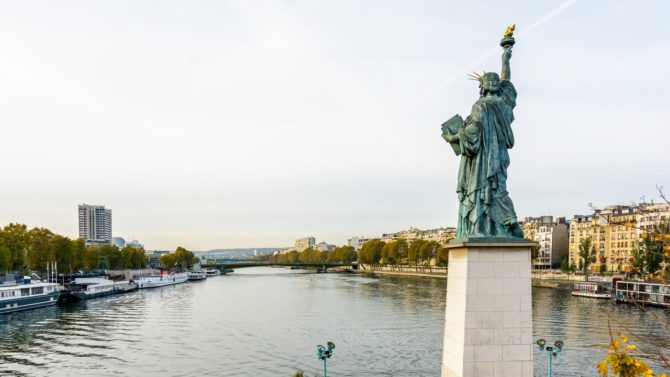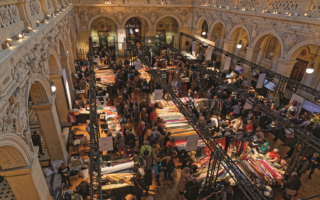French history: The Statue of Liberty’s French roots

Discover how this symbol of the American Dream was designed and created by some of France’s greatest sculptors and engineers
From the moment it was inaugurated on Bedloe’s Island (now Liberty Island) in 1886, the Statue of Liberty became inextricably linked to the American Dream and yet, an immigrant itself, the statue was a gift from the people of France to the fledgling United States of America.
It has many epithets: gatekeeper to New York, popular idol, secular saint, an embodiment of the free world, a good will ambassador for America’s incomers, a Trojan Horse secreting in French nationalism, a discredited symbol of struggle. She – or is it He? – fascinates as much for the story behind its construction as for its colossal scale, rendered progressively smaller by the skyscrapers in its view.
For some, it is the statue’s interior ironwork by engineers Alexandre-Gustave Eiffel and Maurice Koechlin rather than the stern, pre-Soviet-style exterior by sculptor Frédéric Auguste Bartholdi that are the real innovation. In the decades following its installation, numerous statues have been toppled or removed to reflect changing societal values, including Bartholdi’s Columbus in 2020, but not yet his Statue of Liberty. After the Twin Towers were destroyed in 2001, New Yorkers living Downtown could look across the smoking bay to see its enduring presence, while five replicas of ‘Lady Liberty’ are located in Paris, and several others dotted around France.

Who was the Statue of Liberty’s creator, Frédéric Auguste Bartholdi?
Frédéric Auguste Bartholdi (1834-1904) was born in Colmar, Alsace, to counsellor and property owner Jean-Charles Bartholdi and Augusta Charlotte Beysser. At the age of two, Bartholdi’s father died and his mother moved her children to Paris, where her son later studied sculpture and architecture. Ambitious, energetic and prolific, Bartholdi began creating statues of familiar subjects in his early twenties (such as Monument du Général Rapp, 1856, Colmar) setting him on course as a maker of war memorials, of which his crowning achievement was the Lion de Belfort (1880), built from blocks of red sandstone, celebrating French Resistance in Belfort during the Franco-Prussian war.
The sculptor’s taste for the gigantic can be traced back to his travels in Egypt in the 1850s. Egyptomania had coursed through France earlier in the century, spiked by Napoleon’s military campaigns and Champollion’s deciphering of the hieroglyphics on the Rosetta Stone. The Colossi of Memnon and the pyramids at Giza where the head of the Great Sphinx loomed out of the sand deeply impressed Bartholdi, who recorded these and many other sites in drawings and photographs.
When fellow countryman Ferdinand de Lesseps succeeded in opening a passage between the Red Sea and the Mediterranean with the construction of the Suez Canal in 1869, Bartholdi proposed a statue to stand at its mouth at Port Said. Taking as his source material the Colossus of Rhodes, one of the Seven Wonders of the World that depicts the Greek sun-god Helios, Bartholdi produced designs and plaster models of a female figure to serve as a lighthouse and called it ‘Egypt Carrying the Light to Asia’. But his meeting with the ruling khedive ended in cruel disappointment and his plans were firmly rejected as too costly; Bartholdi returned to France, never to visit the Middle East again.

What inspired the Statue of Liberty?
It is possible that this work was not wasted and that the design of a robed female fellah (Egyptian labourer) holding a torch was adapted for a yet grander project, Liberty Enlightening the World. The genesis of the Statue of Liberty is said to have originated at a dinner party of strongly individualist Frenchmen in the home of Édouard René de Laboulaye in Versailles in 1865. Laboulaye was a prominent political thinker, president of the French Anti-Slavery Society and a staunch supporter of the Union side in the American Civil War. To celebrate the Union victory, Laboulaye floated the idea of a monument in the hope that it would further the cause for democracy in France – then under the rule of Napoleon III – by honouring the United States. It’s tempting to picture Bartholdi at the dinner table, reaching for his sack of plaster.
It took more than 20 years to bring the project to fruition, with the intervening Franco-Prussian war that saw Alsace, Bartholdi’s birthplace, lost to the victorious Prussians. Had it not been for the determination of Laboulaye, Bartholdi and de Lesseps on the French side, and William Maxwell Evarts, John Wein Forney, Nathan Appleton and Joseph Pulitzer on the American, it is doubtful whether the Statue of Liberty would ever have succeeded. Funds for its creation were raised by subscriptions, with Bartholdi making several trips across the waters to the States.
His maquettes show a figure dressed in a shallow-folded robe, in the form of a column to mitigate against the effects of the high winds in New York harbour. Both of Liberty’s strong arms hold symbols: one raises high a flaming torch that Laboulaye described as ‘a beacon that enlightens’ rather than a revolutionary incendiary torch, while the other bears a tablet inscribed with the date July 4th 1776 – an explicit reference to the Declaration of American Independence. At her feet lies the broken shackle of servitude.

Where was the Statue of Liberty made?
Liberty’s head and her torch-bearing arm were the first sections to be completed at Gaget, Gauthier et Cie, the workshop in Paris, at 25 Rue de Chazelles. According to Bartholdi, the head’s rather masculine appearance was modelled on his mother (although some commentators say it resembles more closely his older brother) and the statue’s distinctive crown comprises seven rays of sunlight illuminating the seven continents.
The construction of the statue was well documented, with photographs appearing in newspapers to promote interest and raise finance. Both torch and head were exhibited with this same motive in mind. The torch was shipped to Philadelphia’s Centennial Exposition where visitors paid to climb up inside it and a year later in 1878 the head was displayed at the Paris Exposition. Its creator must surely have recalled the monumental body parts he had seen in Egypt as viewers stood in awe before this Surreal apparition that dwarfed the surrounding trees and rendered Parisians Lilliputian. As the statue grew above the rooftops of Rue de Chazelles, it became one of the favourite spots for the curious, among them Victor Hugo. A journalist of the time wrote, “One can imagine we’re in some kind of fairyland where a factory of dwarfs is building a metal giant.” Small replicas were also sold to raise funds.

How was the Statue of Liberty made?
At Gaget, Gauthier et Cie, three enlargements were made in plaster from a clay model before carpenters set to work on the massive wooden frame built over the contours of the full-scale plaster model. Onto this were hammered and shaped three hundred thin copper sheets to form the shell. Bartholdi had conceived that his statue would be painted gold but, in the event, oxidisation from the elements turned her copper skin green, the colour of an American dollar bill.
To ensure that the 46-metre-high statue remained upright and not in danger of tipping into the bay below, Bartholdi required a technician of great skill and engaged engineer Emmanuel Viollet-le-Duc. On his death in 1879, Gustave Eiffel and Maurice Koechlin took over and designed a four-legged pylon of iron bones within the hollow skin of the statue, attached to it by a frame of metal straps called ‘saddles’. This meant that Bartholdi’s exterior was not load-bearing and allowed some ‘give’ to prevent it cracking; the pylon also anticipated the iron lattice tower for which Gustave Eiffel became famous.
Once complete, Liberty was taken down and its sections packed away in labelled crates for shipment to New York where it was reassembled and placed on a pedestal built within the walls of Fort Wood by Richard Morris Hunt. On the day of its inauguration, President Grover Cleveland announced:
“We are not here today to bow before the representative of a fierce and war-like god, filled with wrath and vengeance, but instead we contemplate our own peaceful deity keeping watch before the open gates of America.”
It has not been a good time for statues. By virtue of its size and location, and the fact that it embodies an ideal rather than a portrait of a historical figure, the Statue of Liberty is safer than most, although its replicas have been periodically attacked. Marcel Proust observed that monuments are invisible mirrors to the culture that erected them. If this is so, perhaps we can regard Liberty Enlightening the World as representative of a timeless ideal that is also a work in progress: one that keeps the torch burning for a freer and fairer society.
Share to: Facebook Twitter LinkedIn Email
More in France in the US, French city breaks, French history


